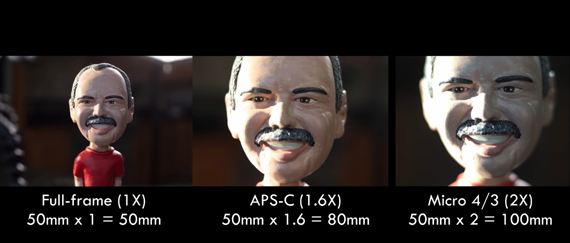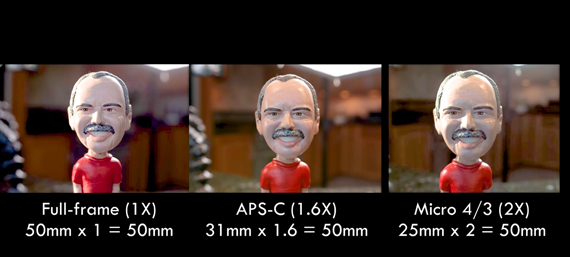A lens’s effective focal length and aperture are affected by the camera’s sensor size. So it’s essential to understand the concept of crop factor and how it affects the results of a lens. Photographer Tony Northrup shares his insight:
Crop factor is basically a numerical value that you can use to convert values among different sensor sizes by simple multiplication.
“With crop factor, just like converting miles per hour to kilometers per hour, you just do simple multiplication.”
The crop factor is entirely dependent on sensor size.
- 35mm full frame cameras have a crop factor of 1
- APS-C cameras have a crop factor of 1.5 (Canon APS-Cs have a crop factor of 1.6)
- Micro Four Thirds cameras have a crop factor of 2
- Phone sensors have a crop factor of around 7 or 8
How Crop Factor Affects Focal Length
To demonstrate how crop factor affects an image, Northrup uses the same lens and mounts it on a full frame, an APS-C, and a Micro Four Thirds camera. He then takes images of his subject from the same distance using the same settings:
The exposure is even in all the above cases. This is because sensor size doesn’t affect exposure. However, there are other things that have changed.
The most prominent difference is the framing. As crop factor increases, it seems as if the image is zoomed in. Smaller sensors capture only the middle part of what a full frame sensor is able to capture.
“Those images are as if we cropped them from the middle of the full frame camera.”
In this case, a 35mm equivalent 50mm lens has worked as a 50*1.6 = 80mm lens on the APS-C body, and a 50*2 = 100mm lens on the micro four thirds body.
Conversely, the APS-C body would require 50/1.6 = 31mm (approx) lens to act as a 50mm full frame lens, and the micro four thirds body would require a 50/2 = 25mm lens for the same purpose.
How Crop Factor Affects Aperture
In the earlier image, the composition looks almost identical in all the images. However, if you notice the background blur, you can still see some difference.
While the full frame sensor produces the most background blur, the micro four thirds camera produces the least. This is because, like focal length, the aperture of the lens is also affected by crop factor.
An aperture setting of f/4 on a full frame is equivalent to 4/1.6 = 2.5 (f/2.5) on an APS-C camera and 4/2 = 2 (f/2) on the micro four thirds camera. Now, if you compare the background blur on these three images, they’re identical.
Therefore, to convert the 35mm full frame equivalent focal length and aperture to your camera sensor equivalent, simply divide by the crop factor.
How Crop Factor Affects ISO
When you reduce the aperture values in the APS-C and micro four thirds cameras to match the aperture value in a full frame camera, you let in more light. This affects the overall exposure of the image. You can compensate for that by reducing the ISO value.
For instance, if you use an ISO of 400 on a full frame camera, the equivalent ISO on a camera with crop factor 1.6 would be around 160.
So, if you remember the following relationships, you can overcome any limitations with cameras having smaller sensors.
“Not only do you get the same amount of background blur, but you’ll get the same amount of noise specially in low light because you’re using a lower ISO.”
Where Crop Factor Breaks Down
Calculations are pretty simple. But they’re not always practical. Consider Northrup’s example. For portraits, he likes to use his 105mm f/1.4 lens.
The problem here is that a 70mm, f/0.9 does not exist. Neither does a 53mm f/0.7 lens. The only solution in such case is to go full frame. Otherwise, the smaller sensors are enough to get the job done for your.
Misconceptions About Crop Factor
Smaller sensors have greater depth of field. This misunderstanding arises because users tend to forget to compare the equivalent aperture values. Always convert the f-stop and focal length whenever comparing results across different sensor sizes.
Small sensor cameras have smaller lenses. Again, if you do not forget to apply the aperture conversion, the lenses producing similar results are approximately the same size. For instance, the APS-C Sigma 18-35mm f/1.8 (approx 27-53mm f/2.7 full frame equivalent) is similar in size to the Canon 24-70mm f/2.8 full frame lens.
Crop factor is applicable to the focal length but not aperture value. Such statements are often made by camera and lens manufacturers. Northrup insists that they do this so that they can overstate their lens’ power. For instance, a 300mm micro four third lens would be the equivalent of a 600mm lens. But when in comes to practice, a 600mm full frame lens produces much better images than a 300mm micro four third lens.
“I wish smaller sensors just made every lens more powerful. But that’s just not the case. There is no substitute for a big huge front element that is gathering a ton of light. That’s what produces all that background blur and gives you amazing low light capabilities. “
Other Facts About Crop Factors and Sensor Size
- Medium format cameras have a crop factor of less than 1. Hasselblad cameras for instance have a crop factor of 0.69.
- 35mm is used as a base value because after Thomas Edison adopted 35mm film for movie cameras, other camera manufactures settled for the same. It later became a standard.
- Crop factor does not affect exposure.
- Full frame cameras gather more light than small sensor cameras at any given ISO and f-stop as they have a greater surface area exposed to light.
I hope this discussion has cleared up any confusion you might have had regarding crop factor. Understanding crop factor will help you in making informed decisions when it comes to purchasing a new lens or a camera body.
Like This Article?
Don't Miss The Next One!
Join over 100,000 photographers of all experience levels who receive our free photography tips and articles to stay current:








No, no, no, no, no. Please stop. Now.
Absolutely -nothing- changes a physical attribute such as focal length. NOTHING. Certainly not the”crop factor”. The reason the smaller sensors need a shorter focal length to get the same image is because of view angle. You were so close, then you went South.
The smaller sensors require a shorter focal length to get the same view, and it is the shorter focal length that produces less blur. Look up the simplified formula for depth of field. And it has nothing to do with sensors size. They’re orthogonal to each other. You’re conflating..
And manufacturers use crop factor as a point of reference, thinking that people know 35mm as a point of reference. Nothing could be further from the truth, especially now. Northrup is mistaken, I believe. Of course, he wouldn’t admit to being wrong, so whatever.
Finally, it is impossible too produce precisely the same image on two different sized sensors. The math does not allow it. Period.
In short, can you edit the article and remove the misinformation?